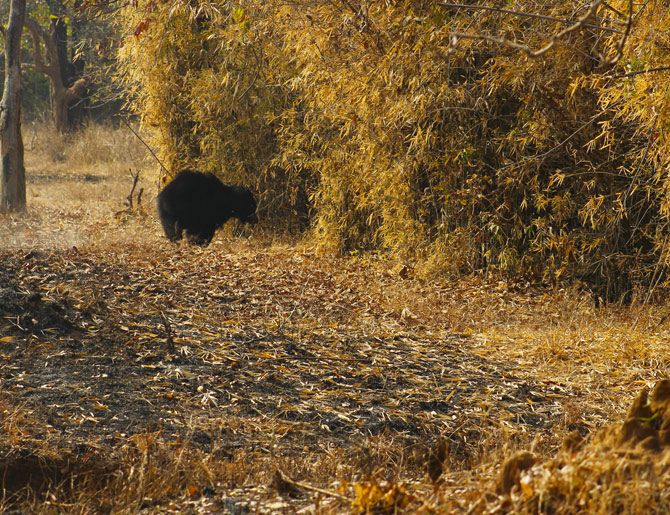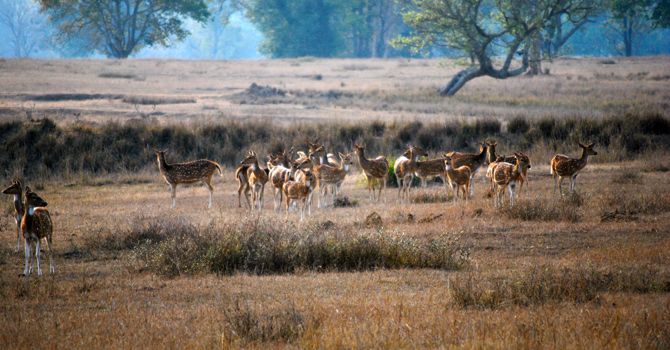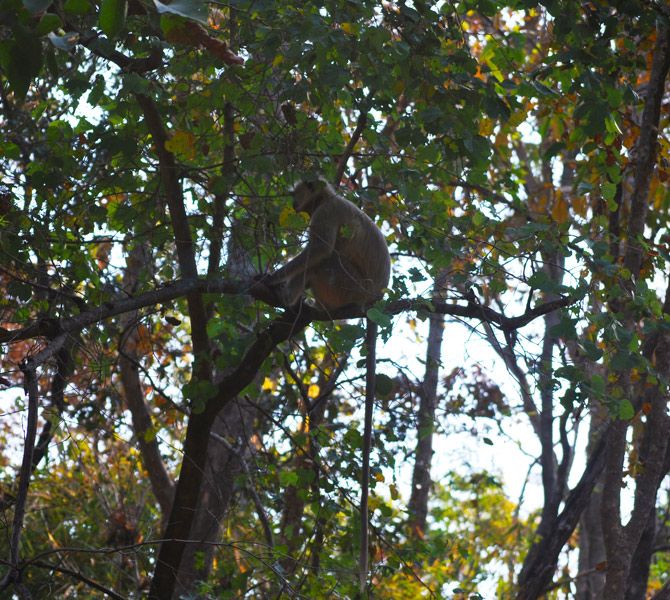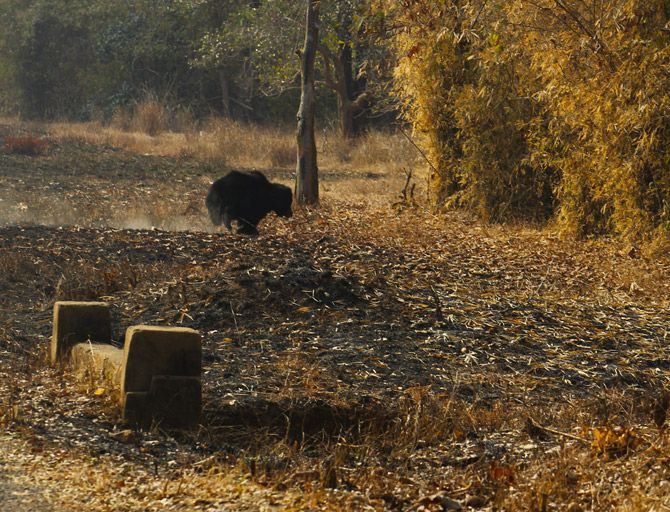'The sambar’s call is louder, more urgent now. It sounds like someone is stuffed in a tight, windowless room, with earthen pots scattered around for the sound effect. Just then, the leaves on our left start to rattle. I am all goose-bumpy as I grip my camera tightly, expecting the tiger to burst out of the bushes and over our heads.'
'This is indeed a rare sight. I have never seen a langur pee from a height of 20 metres and look nonchalant about it!'
Shubir Rishi/Rediff.com continues his jungle adventure and narrates his last day at the Kanha National Park.

We are at lunch, but no one except a few really hungry people is eating. They are all talking about the only one thing. Tigers. Pictures are shared, the entire tiger-chase-deer sequence is repeated so many times I can now repeat it verbatim in my sleep.
We are sort of pariahs. People know of our misfortune until now, tut, pat and move along. Almost everyone has an exciting tiger story to tell, but all we have is recount and recall the number of deer we have seen; in fact, we have seen so many, we have started numbering now.
As we shuffle towards our car for the safari, I rub Siddharth’s belly (who has been credited with many tiger spottings, so much so that people clamour over each other to take him along in the car), and say, “Give me some of that luck.”
We enter the park and are immediately rewarded with a (multiple) deer sighting. As the driver attempts to stop the car, I tap him on the shoulder, “Unless it is 70ft tall, please do not bother stopping for deer.”
The driver acknowledges by stepping on the accelerator so hard, it nearly knocks off Suji, who is standing on one foot, putting a show on for another car carrying a bunch of ladies.
As we climb a sort of hillock, a strange, loud sound rings out. We look at each other quizzically. The guide is quick on his feet, excitement apparent on his face.
“It is a sambar call. The tiger has to be nearby,” he says, narrowing his eyes and suddenly transforming into Clint Eastwood, his squint accentuated by the deep lines on his face.
“Chal!” he commands the driver who as usual accelerates without warning, and speeds upwards. But a couple of jeeps are already there and they look at us in dismay, regarding us as unwanted guests.
The sambar’s call is louder, more urgent now. It sounds like someone is stuffed in a tight, windowless room, with earthen pots scattered around for the sound effect. Just then, the leaves on our left start to rattle. I am all goose-bumpy as I grip my camera tightly, expecting the tiger to burst out of the bushes and over our heads.
A langur does that instead, shrieking and crying out loudly. It is visibly scared and can’t seem to contain himself; his shrieks getting louder by the minute.
“The tiger is very close,” the guide repeats, “It is behind that incline,” he says, nodding to our right. We crane our necks in that direction, willing the tiger to appear.
The langur is going bananas. He jumps from one branch to another, screeching non-stop, finds a sal tree, and climbs rapidly. In a matter of mere seconds, it is seated on the highest branch, grabbing it with its paws and shaking it wildly. The screaming has not stopped and it has the guide very alarmed.
“Shayad do tiger hain (maybe there are two tigers),” he says, making all of us stand up on our seats in anticipation.
Meanwhile, more cars have arrived from both directions, and are taking in the scene. They have been watching the drama unfold and are furiously clicking away at the monkey, as if expecting him to summon a tiger somehow.
Just then the langur starts screeching, and lets himself go.
“Wow,” I exclaim. “This is indeed a rare sight. I have never seen a langur pee from a height of 20 metres and look nonchalant about it!” Others too seem to be mesmerised and amused by the sight. Someone roars with laughter.
The sudden release has calmed the monkey somewhat. It has climbed down and now sits in a contemplative mood, absently scratching itself, the tiger forgotten. The sambar has gone quiet too.
“Bhaiyya, tiger ka kya hua (whatever happened to the tiger?),” someone asks in the other car, something we all have been wanting to ask.
“Shayad so gaya (likely it slept),” sighs our guide, and asks the driver to take us to a nearby watering hole that is favoured by the tiger.
We arrive near a half-dry lake, where around 10 safaris are already camping, and by the look of it, they have been here for a while. A group is humming a song in chorus, men and women are busy pouting and taking selfies (though it is illegal to carry your phone inside the park), others are snacking noisily from bright orange packets. It’s a regular picnic; no one seems to realise just exactly where they are.
Another group, in a safari, is unaware of this lively action around them, and has slept off, the blazing heat notwithstanding. The only persons awake in the group are, unsurprisingly, the driver and the guide.
We stop at this spot, and resign ourselves to a long, pointless wait. Someone spots an alleged crocodile resting on the banks, and cameras start zooming. And boy, is that a fat crocodile!
And so, after a 30-minute wait, which includes taking macro shots of a tree bark, a dry leaf and a spider’s web, we head back. As usual, deathly silence accompanies us. Even the guard and the driver, who usually try to lighten the mood, are mum.
Then, movement. There is something big inside a ditch to our left, 50 metres ahead. The jeep slows down, cameras are switched on, lens caps come off and a black blur suddenly comes into focus.
There is a sudden scramble on the left. A large, looming messy-looking creature, with extremely shaggy black hair leaps from the ditch and on to the road.
“It’s a sloth bear!” exclaims our guide, his mouth open.
It stops and stands on its hind legs -- nearly 6 feet tall and pretty lean for a bear (around 130 kg), -- and looks at our jeep which has now almost come to a halt. Then it bolts nimbly and energetically -- letting it be known that it’s just a moniker and it has nothing to do with sloth, and disappears into bushes on the other side of the road.
It is over in less than 4 seconds. We rush to the spot where it is still visible, albeit barely, in the thick bush, and a car rolls up behind us.
“Kya dekha (what did you see?)”a voice rings out, deafening in the silence, making each of us wince. “Bhaloo hai (it’s a bear)…SHHH,” responds our guard angrily, then says in a low growl, “This is a very temperamental animal; if you piss it off, it will come and attack you.”
But the bear has forgotten all about us and has moved deep inside the bushes, and we can only hear faint rustling. And so we move on, leaving behind the car which is furiously photographing the bush from all angles.
We are elated! We finally have something to talk about; others are as usual talking about the tigers and leopards they have seen today, but no one has seen a bear yet. So yes, spotting a sloth bear is indeed a rare event.
As we come out of the park, we find others comparing notes. Hemanshu aka 'Daya' looms over to us, and asks," Tiger dikha? (Did you see a tiger?)." No, I retort with a smirk, "Bhaloo dikha (We saw a bear)," leaving him stare at our group open-mouthed.
So now we are the only people in the group to have seen a sloth bear. Which is a thing of awe for some, and for others it is like we have won a consolation prize. We shake hands with the driver and the guide, thanking them profusely for their efforts, and leave with a generous tip (always tip these guys folks, they are rad!)
Either way, the jungle in Kanha rejuvenates you. Animals or no animals, just being in the jungle gives you a sense of calm, tiger alert notwithstanding. And it makes you want to stay back.
And that was our last day in Kanha. We were to now pack up and drive all the way to the Tadoba Reserve, back in Maharashtra. A long drive of roughly 500 km lay ahead, and we all got busy packing our bags, and feeding our faces.
Next and final stop: Tadoba National Park, Maharashtra
Day 1: Oh, to catch a tiger by its tale!
Day 2: Locking horns with the fearless Indian Bison
Day 3: Along came a tigress...










